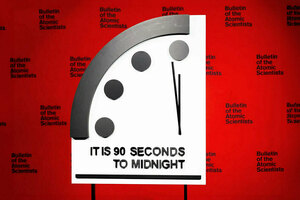
“The unleashed power of the atom has changed everything except our thinking. Thus, we are drifting toward catastrophe beyond conception. We shall require a substantially new manner of thinking if mankind is to survive.” --Albert Einstein, May 1946
On Tuesday, Jan. 23, the hand of the symbolic Doomsday Clock, overseen by the Science and Security Board of the Bulletin of Atomic Scientists, remained frozen at 90 seconds to midnight in its 2024 update.
And the meaning behind this announcement? That while seemingly stable, the world remains on the precipice. The unchanged timing from 2023 to 2024 underscores the persistent global threats that have the power to inch the metaphorical needle closer to midnight.
Since its inception in 1947, the Doomsday Clock has served as a symbolic visual to translate threats to humanity and the Earth into a countdown to zero. This representation encompasses a spectrum of dangers, from nuclear explosions to climate change, biological threats, and disruptive technologies like artificial intelligence. Annually, the organization grapples with two pivotal questions guiding the clock's timing: 1) Is humanity safer or at risk this year compared to the last, and 2) Is humanity safer or at greater risk compared to the 77 years since the clock was first set?
Gerard F. Powers, director of Catholic Peacebuilding Studies and coordinator of the Catholic Peacebuilding Network at the Kroc Institute for International Peace Studies, highlights a paradox of our time, noting, "In the past two decades, there has never been more sustained, broad, and high-level support for nuclear disarmament, not only as a moral imperative but as a policy objective."
Yet the echoes of the 1962 Cuban Missile Crisis reverberate. Russia's suspension of the New Strategic Arms Reduction Treaty in February 2023 and the escalating nuclear arms race between China, Russia, and the United States intensify the threat of nuclear war.
George A. Lopez, Rev. Theodore M. Hesburgh, C.S.C., professor emeritus of peace studies, contemplates a potential shift in trajectory, suggesting, "If there were new mechanisms of inspections, new acts of goodwill, or a new global condemnation of the whole enterprise of nuclear weapons, the clock could have moved further away from midnight."
Board members factor imminent threats like rising global temperatures, floods, and wildfires into the Clock's calculation. “Including climate change remains one of the most controversial decisions taken by the organization," wrote Rachel Bronson, president and CEO of the Bulletin of Atomic Scientists, in the December 2023 issue of Peace Policy. By adding climate change to the Clock’s tally, the narrative shifts – from solely assessing how close the world is to destruction by nuclear weapons, to how humanity itself contributes to destruction through its creations, namely technology.
The advent of instant access to diverse news sources introduces a new dimension to the complex tapestry of global threats. Lopez identifies two clusters of problems: 1) the continual bombardment of distressing news, leading to desensitization, and 2) the risk of individuals either disengaging from news consumption altogether or succumbing to the belief that nuclear war can be prevented only through deterrence.
These challenges could be tackled through the insights of experts advocating for fresh approaches — methods of scrutiny, positive actions, and a global consensus against nuclear weapons, all of which can help move the clock further from midnight.
“Pessimism must not give way to despair,” said Powers. “Climate change and nuclear war are not inevitable. They are human problems that require human solutions. Just as the world has banned torture, slavery, and chemical weapons, the world must ban nuclear weapons - even war itself.”
Founded in 1945 by Albert Einstein, J. Robert Oppenheimer, and University of Chicago scientists who helped develop the first atomic weapons in the Manhattan Project, the Bulletin of the Atomic Scientists created the Doomsday Clock two years later, using the imagery of apocalypse (midnight) and the contemporary idiom of nuclear explosion (countdown to zero) to convey threats to humanity and the planet. The Doomsday Clock is set every year by the Bulletin’s Science and Security Board in consultation with its Board of Sponsors, which includes nine Nobel laureates. The Clock has become a universally recognized indicator of the world’s vulnerability to global catastrophe caused by man-made technologies.